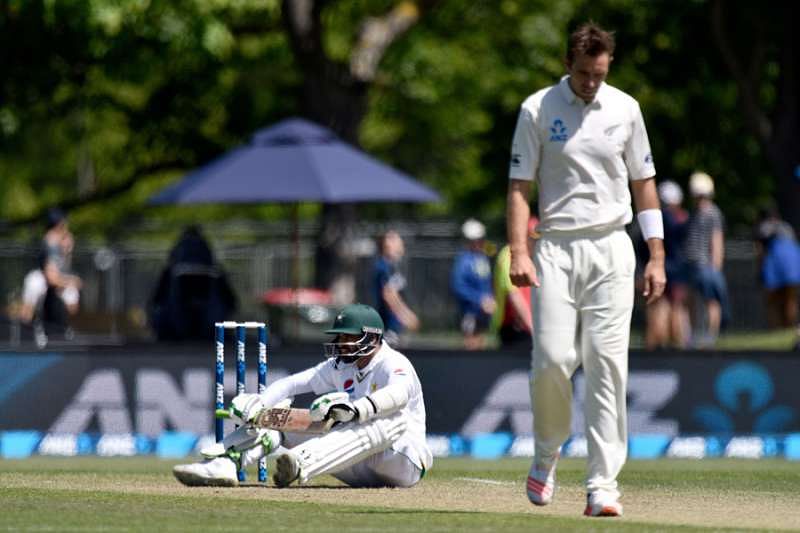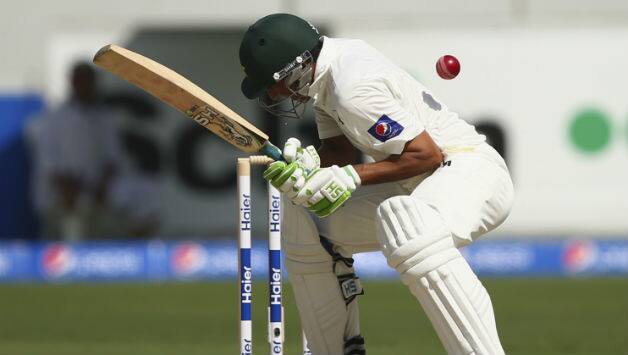
Pakistani batsmen's lack of composure cost them the 1st Test against New Zealand

The New Zealand skipper was happy when he won the toss. After losing three tosses in a row during the Test series against India, Kane Williamson finally got an opportunity to take control of proceedings. Without a second thought, he decided to bowl first at the Hagley Oval which was tailor-made for swing and seam bowling and his pace bowlers didn’t let him down at all.
‘Grand’ debut for Colin
Tim Southee and Trent Boult tested Sami Aslam and Azhar Ali for the first twelve overs, but as soon as the medium-pacer Colin de Grandhomme came into the attack and moved the ball from a three-quarter length, Pakistan batsmen found the going tough. 31 for 0 became 88 for 5 and after a while, Pakistan were all out for 133.
When the Pakistan pace attack started to bowl with fantastic rhythm and guile, 133 looked to be a decent total. Despite Jeet Raval and Henry Nicholl’s stubborn resistance, New Zealand managed just 200 runs on day 3, but they still possessed a handy lead of 67 runs.
Also read: All you need to know about Colin de Grandhomme
By then, the track had lost its volatility and became a bit easier for batting. It provided a wonderful opportunity for Pakistan to overshadow the horrors of the first innings by batting productively and stabilise their position in the Test.
The ideal way to establish authority in such conditions is to spend more time at the crease and give the fast bowlers the first hour. It’s an old fashioned way of batsmanship, but still very effective when the new ball poses a lot of threat.
Azhar and Azam steady Pakistan
Pakistan lost Sami early, but Azhar and Babar Azam followed the old fashioned way of Test batsmanship. They weathered the new-ball storm with a lot of patience and determination. Both of them slowed down the scoring rate but were able to block and leave the balls which posed a threat. Such batting was not pleasing to the eye, but at least they ensured there was no further collapse with just an hour or so remaining in the day's play.
Williamson was desperate for a breakthrough and threw the ball to his most trusted ally, Neil Wagner, to apply pressure on the Pakistan batsmen via his barrage of short-pitch and ribcage bowling.
Wagner triggers the collapse
Time and again, Wagner’s tireless spells from around and over the wicket have tested the batsmen to their limits and he has been successful both in breaking partnerships and triggering collapses.
Sri Lanka experienced the same last year, while teams like Australia could sustain the heat of Wagner only by remaining composed and technically sound. Bowlers like Wagner unleash crucial passages of play when they build heads of steam and charge in like raging bulls. To counter the same, a batsman has to be patient and composed enough to weather the storm and then cash in at a later stage.
But the Pakistani batting line up melted.
Wagner banged the ball short on a middle-and-leg stump line. Azhar and Babar found the going extremely tough and in the fifth ball of the 40th over, Babar was caught down the leg side to a ball which he could have easily left.
Lack of composure proves to be the downfall
Then Younis Khan was done in by a ball which reared from short-of-a-length around leg stump and hurtled towards him. Younis failed to keep his hands down and was caught behind. Two quick wickets and it was up to Misbah-ul-Haq to arrest a collapse and end the day without further damage. But he also capsized against the short stuff. But this time, it was a rush of blood and poor shot selection that did him in.
Misbah is not known for his attacking strokes and when the circumstances are tough, he concentrates more on keeping his composure and strike rotation rather than dealing with boundaries. But at the fag end of day 3, he lost his cool and went for the hook shot which led to a collapse from which Pakistan never recovered.
New Zealand bagged the first Test with an eight-wicket win and Pakistan were left to ponder that eventful one hour or so in which they failed to maintain their composure under pressure.
On day 3, in the second innings, Pakistan’s plan was to spend time at the crease. It was a good move under the circumstances, and with proper application, could have proved to be fruitful. However, a brain freeze from the batsmen ensured that they paid a heavy price.
The picture could have been different had they not failed to maintain their composure. Misbah and his men will be looking to bounce back from the disappointment and level the series when the two sides clash in the second Test at Hamilton.


